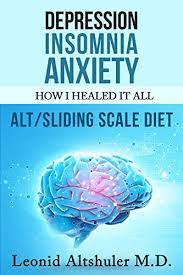Mixed Anxiety Depressive Disorder
Mixed anxiety depressive disorder, also known as MADD, is a mental health condition that combines symptoms of both anxiety and depression. Individuals with MADD experience a mix of symptoms from these two common mental health disorders, making it challenging to diagnose and treat.
People with MADD may feel constant worry, fear, or unease along with feelings of sadness, hopelessness, or emptiness. They may also have trouble concentrating, experience changes in appetite or sleep patterns, and struggle with low energy levels.
Diagnosing MADD can be complex due to the overlap of symptoms with both anxiety disorders and depressive disorders. It is essential for individuals experiencing these symptoms to seek help from a mental health professional for an accurate diagnosis and appropriate treatment plan.
Treatment for mixed anxiety depressive disorder often involves a combination of therapy, medication, and lifestyle changes. Cognitive-behavioral therapy (CBT) can help individuals learn coping strategies to manage their symptoms effectively. Antidepressants or anti-anxiety medications may be prescribed to alleviate the emotional and physical symptoms of MADD.
Self-care practices such as regular exercise, healthy eating habits, sufficient sleep, and stress management techniques can also play a crucial role in managing mixed anxiety depressive disorder. Building a strong support system of friends, family, or support groups can provide additional emotional support during difficult times.
It’s important for individuals with MADD to prioritize their mental health and seek professional help when needed. With proper diagnosis and treatment, it is possible to manage the symptoms of mixed anxiety depressive disorder and improve overall well-being.
“Understanding Mixed Anxiety and Depression: DSM Classification Explained”
“The Intersection of Emotions: Recognizing Concurrent Anxiety and Depression”
4. “Identifying
- How do you deal with mixed anxiety-depressive disorder?
- Is mixed anxiety and depression a DSM disorder?
- Can you have a mix of anxiety and depression?
- What are the symptoms of mixed anxiety-depressive disorder?
- What is the drug of choice for mixed anxiety-depressive disorder?
How do you deal with mixed anxiety-depressive disorder?
Dealing with mixed anxiety-depressive disorder involves a comprehensive approach that addresses both the anxiety and depressive symptoms. Seeking professional help from a mental health provider is crucial in developing an individualized treatment plan. Therapy, such as cognitive-behavioral therapy (CBT), can help individuals learn coping strategies to manage their symptoms effectively. Medication may also be prescribed to alleviate emotional and physical symptoms. Additionally, incorporating self-care practices like regular exercise, healthy eating, and stress management techniques can support overall well-being. Building a strong support system of friends, family, or support groups can provide additional emotional support during the challenging times associated with mixed anxiety-depressive disorder.
Is mixed anxiety and depression a DSM disorder?
Mixed anxiety and depression, often referred to as mixed anxiety depressive disorder (MADD), is not currently recognized as a distinct disorder in the Diagnostic and Statistical Manual of Mental Disorders (DSM-5). While the DSM-5 provides criteria for various anxiety disorders and depressive disorders separately, the overlap of symptoms in MADD makes it challenging to categorize as a separate diagnostic entity. However, mental health professionals may still diagnose and treat individuals experiencing symptoms of both anxiety and depression, using a combination of therapeutic approaches tailored to address their specific needs. It is important for individuals seeking help for mixed anxiety and depression to consult with a qualified mental health provider for an accurate assessment and appropriate treatment plan.
Can you have a mix of anxiety and depression?
Yes, it is possible to experience a mix of anxiety and depression, known as mixed anxiety depressive disorder (MADD). Individuals with MADD may exhibit symptoms of both anxiety and depression simultaneously, such as persistent worry, fear, sadness, and hopelessness. The coexistence of these two common mental health conditions can create a complex and challenging emotional state for those affected. Seeking professional help from a mental health provider is essential for accurate diagnosis and appropriate treatment to address the symptoms of mixed anxiety depressive disorder effectively.
What are the symptoms of mixed anxiety-depressive disorder?
Mixed anxiety-depressive disorder, often abbreviated as MADD, presents a combination of symptoms from both anxiety and depression. Common symptoms of this disorder include persistent feelings of worry, fear, or unease, along with feelings of sadness, hopelessness, or emptiness. Individuals with MADD may also experience difficulty concentrating, changes in appetite or sleep patterns, and low energy levels. These overlapping symptoms make it challenging to differentiate between anxiety and depression alone, highlighting the complexity of diagnosing and treating mixed anxiety-depressive disorder effectively. If you are experiencing these symptoms, seeking professional help for an accurate diagnosis and tailored treatment plan is crucial for managing MADD.
What is the drug of choice for mixed anxiety-depressive disorder?
The choice of medication for mixed anxiety-depressive disorder depends on the individual’s specific symptoms and medical history. In general, selective serotonin reuptake inhibitors (SSRIs) and serotonin-norepinephrine reuptake inhibitors (SNRIs) are commonly prescribed for managing the symptoms of mixed anxiety-depressive disorder. These medications can help alleviate both anxiety and depression symptoms by balancing neurotransmitters in the brain. However, it is crucial for a qualified healthcare provider to assess each person’s condition and tailor the medication regimen to their unique needs to ensure optimal effectiveness and minimal side effects.



